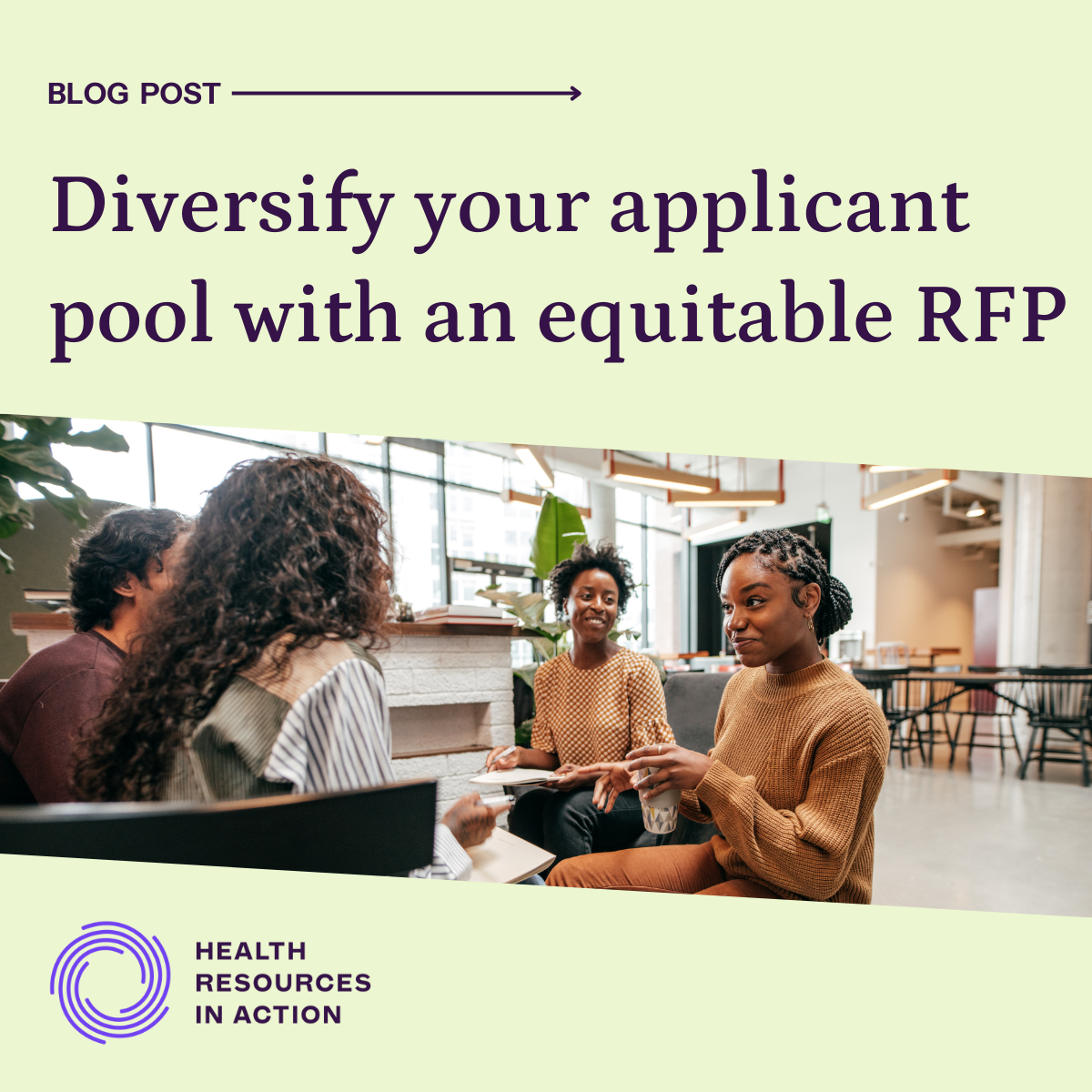
The Request for Proposal (RFP) process is commonly used by foundations and grantmakers to promote a funding opportunity. Too often, RFPs are long, confusing, and burdensome. This creates unnecessary barriers to entry for organizations with less infrastructure, frequently resulting in grants going to “the usual suspects.” Funding the same organizations again and again can limit your portfolio’s potential impact. Diversifying your applicant and awardee pools can help move the needle, but doing so requires equity considerations well before you reach the proposal review stage.
A request for proposals (RFP) is a funder’s written announcement inviting proposals, usually for a specific grant program.
In the case of our grantmaking work, we keep our Health Equity Framework top of mind to help “ensure funding opportunities are accessible and transparent, prioritize resources for approaches that address the root causes of inequities, and shift the landscape of who predominantly receives funding,” says Jennifer Lee, HRiA’s Vice President of Grantmaking. We can all increase our impact by addressing barriers to funding diversification. The approaches below can get you started on the path to embedding equity throughout the preparation, writing, and application phases of the RFP development process.
Preparing to write the RFP
Before writing an RFP, take a step back to align stakeholder and funding needs with an eye toward equitable practices and outcomes. Establish a diverse writing team to ensure representation of many perspectives. Key considerations include:
- Previous RFPs. Analyze past RFP processes to uncover strengths and potential opportunities. Spend time discussing where greater attention to equity is needed. Include voices that may have been missing from your prior endeavors. Distill the most salient points to elicit the critical information needed from applicants.
- Timeline. Create reasonable application and programmatic timelines. Accelerated timelines limit the types of organizations and entities that can submit a competitive application and/or complete the scope of work. Early planning helps advance equity and optimize the grantee/awardee match.
- Budget. Align your budget with the needs of potential applicants. Assess market rates for your requested services or deliverables to inform your planned investment. Confirm the scope of your project can be accomplished within the available budget.
- Eligibility. Ask how eligibility criteria can facilitate a more inclusive applicant pool. For instance, potential applicants might not have 501c3 designation and rely on a fiscal agent. If your funding source allows, make sure your RFP is inclusive of broad applicant types.
Writing an equitable RFP
An equitable RFP communicates the information needed by the funder with clarity, conciseness, and consistency. It offers a glimpse into what a partner can expect when working with you and helps build trust between the two parties. As writing continues, be mindful of the following:
- Audience. Will your audience be able to apply with relative ease? Consider the types of organizations you hope to fund. Some may not have the grant writing or administrative capacity to support proposal development, so clarity is of utmost importance. Use headings in your document, keep sentences short, and avoid jargon.
- Proposal requirements. What are the essential requirements for your RFP? Including a lengthy list of must-haves will limit your pool of applicants. Keep requirements to the necessary items that meet your needs to cast the widest net.
- Proposal format. Can you offer flexibility in submission format? Present multiple options for applicants to submit their proposals. For example, the MA Community Health and Healthy Aging Funds advises applicants to use “a mix of bulleted lists, narrative writing, and visual media” in their proposals.
- Proposal guidelines. Are your instructions clear and straightforward? Include enough specifics around scope of work, budget, and evaluation criteria so that applicants can respond appropriately, but not so much that the requirements become muddled and confusing.
- Program requirements. Have you plainly stated your non-negotiables? Be transparent about required activities so prospective applicants can decide if they can do the work for the funding level you’ve offered.
- Budget details. Who will cover the cost of any required activities? Be explicit about whether required activities should be included in the proposed budget, or if you as the funder will cover them. For instance, if you have specific evaluation or reporting requirements, include that information up front, providing applicants a chance to assess the capacity and resources needed to meet those requirements.
- Triple check information. Do you need to update any key details? Check for inconsistencies, such as dates that don’t match, typos, and misspelled words. Ensure all assumptions and requirements are addressed. If there are last-minute changes to the budget, timeline, forms, etcetera, confirm they are included in the final version of your document.
Facilitating an equitable application process
An equitable RFP goes beyond writing. Generating awareness and facilitating a smooth submission process are essential steps to creating an equitable funding opportunity. Below are three areas within the application experience that should not be overlooked.
- Messaging and dissemination. Determine the channels you will use to help applicants learn about your RFP, including any partners that could amplify your reach. Ensure your promotional messaging is straightforward. Address any anticipated literacy and language needs among your audience.
- Application support. Acknowledge and address barriers to participation. For example, schedule your pre-submission events, such as your bidders’ conference or funding announcement session, at different times to account for people who work atypical hours. Record your sessions and make them available for applicants through your website or portal.
- Submission procedures. Evaluate the proposal submission process for barriers. Create multiple touchpoints for prospective applicants. Offer applicants the opportunity to ask questions and receive answers well before the due date.
Conclusion
Equitable RFPs are easy to understand, transparent, internally consistent, reasonable, and facilitate diversity in applications. However, the RFP is one piece of a larger puzzle. We must apply an equity lens to the entire grantmaking process, including proposal review and scoring, contracting, payment, and reporting. By challenging our assumptions, we can transform the RFP into a vehicle to advance economic, health, and racial equity.

